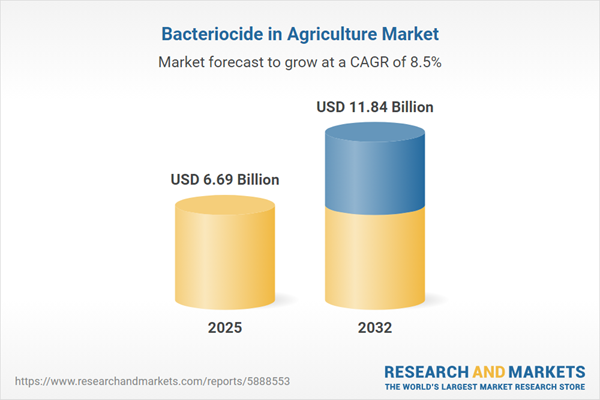Speak directly to the analyst to clarify any post sales queries you may have.
Senior leaders operating in the bacteriocide in agriculture market must navigate evolving sustainability pressures, regulatory environments, and operational efficiency targets across diverse global supply networks. This requires a future-focused approach that aligns compliance, innovation, and resilient distribution strategies to support commercial objectives effectively.
Bacteriocide in Agriculture Market Snapshot
The bacteriocide in agriculture market demonstrates strong growth, moving from a valuation of USD 6.17 billion in 2024 to USD 6.69 billion by 2025, with projections reaching USD 11.84 billion by 2032. The sector is advancing at an 8.47% CAGR, propelled by ongoing regulatory reforms, dedicated sustainability commitments, and active investments in digital and operational modernization. Industry participants are investing in technology upgrades, refining quality controls, and optimizing distribution systems to address global logistics complexities. Compliance with both domestic and international regulations has become central to achieving competitive advantage and supporting long-term transformation across this space.
Bacteriocide in Agriculture Market: Scope & Segmentation
- Formulation Types: Includes emulsions, granules, liquids, and powders, ensuring adaptability for crop-specific and operational needs while supporting safety and compliance benchmarks.
- Crop Categories: Covers cereals, grains, fruits, vegetables, cucurbits, leafy greens, solanaceous crops, oilseeds, and pulses, accommodating both essential food staples and higher-value specialty crops.
- Application Modes: Spans foliar spraying, postharvest treatments, seed-targeted approaches, and soil applications to facilitate integration with targeted disease and pest management programs.
- Active Ingredients: Features biochemical and biological agents, including bacteria-, fungi-, and phage-based solutions, alongside established chemical compounds to enable integrated, sustainable crop protection strategies.
- Distribution Channels: Utilizes direct procurement, distributor networks, retailer sales, and e-commerce platforms, which collectively provide accessible sourcing for both multinational operations and regional stakeholders.
- Regional Markets: The Americas, EMEA, and Asia-Pacific regions each present diverse regulatory requirements, technology adoption rates, and varying risk profiles essential for market expansion and compliance planning.
- Leading Companies: Industry leadership is demonstrated by Bayer CropScience AG, Syngenta Crop Protection AG, BASF SE, Corteva, FMC Corporation, ADAMA Agricultural Solutions, UPL Limited, Sumitomo Chemical, Nufarm Limited, and Valent BioSciences, known for product development focus and adaptive market strategies.
Bacteriocide in Agriculture Market: Key Takeaways
- Advances in chemical and biological solutions enable growers to respond effectively to evolving disease challenges and resistance pressures, supporting diverse farming systems globally.
- The move toward lower-residue bacteriocide formulations is prompting upgrades in production processes and robust adherence to new food safety and sustainability guidelines in the agricultural sector.
- Increasing integration of digital and precision agriculture tools drives better resource efficiency and ensures alignment with environmental targets, fostering smarter, data-driven farm operations.
- Interdisciplinary collaboration among biotechnology, agrochemical, and agri-tech leaders is accelerating new product development and supporting timely responses to regulatory and operational shifts.
- Supply chain and procurement strategies are evolving to emphasize domestic production and regional partnerships, strengthening resilience and reducing exposure to global supply uncertainties and regulatory risk.
Tariff Impact on Supply Chains and Cost Structures
The imposition of recent U.S. tariffs has heightened costs for key agricultural inputs, prompting organizations to diversify sourcing strategies. Market participants are pursuing domestic manufacturing initiatives and reinforcing intra-regional alliances, aiming to enhance stability and adaptability across international agricultural supply chains.
Methodology & Data Sources
This analysis is grounded in peer-reviewed literature, official regulatory records, and detailed industry evaluation. Insights reflect input from more than forty subject matter experts and leverage quantitative models and scenario-based analysis to ensure an accurate assessment of current and emerging market trends.
Why This Report Matters
- Enables executive leaders to strategically align growth priorities and investment in R&D and compliance to changing regulatory and agri-technology environments.
- Provides operational and procurement managers with practical intelligence to strengthen risk management and secure business continuity amid evolving supply chain conditions.
- Presents market-driven insights that empower leaders to form adaptive business models and partnerships in response to shifting global agricultural demands.
Conclusion
Continued progress in the bacteriocide in agriculture market depends on strengthening strategic and technical abilities. By investing in adaptable and reliable supply ecosystems, organizations can reinforce operational performance and support future market resilience.
Additional Product Information:
- Purchase of this report includes 1 year online access with quarterly updates.
- This report can be updated on request. Please contact our Customer Experience team using the Ask a Question widget on our website.
Table of Contents
3. Executive Summary
4. Market Overview
7. Cumulative Impact of Artificial Intelligence 2025
Companies Mentioned
The companies profiled in this Bacteriocide in Agriculture market report include:- Bayer CropScience AG
- Syngenta Crop Protection AG
- BASF SE
- Corteva, Inc.
- FMC Corporation
- ADAMA Agricultural Solutions Ltd.
- UPL Limited
- Sumitomo Chemical Co., Ltd.
- Nufarm Limited
- Valent BioSciences LLC
Table Information
| Report Attribute | Details |
|---|---|
| No. of Pages | 183 |
| Published | November 2025 |
| Forecast Period | 2025 - 2032 |
| Estimated Market Value ( USD | $ 6.69 Billion |
| Forecasted Market Value ( USD | $ 11.84 Billion |
| Compound Annual Growth Rate | 8.4% |
| Regions Covered | Global |
| No. of Companies Mentioned | 11 |









